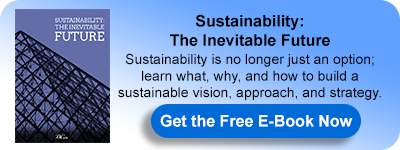How Big is Your Business’s Environmental Footprint?
Changing the Perception of Waste
To achieve sustainability as an organization, one of the first steps is to become aware of the environmental impact one’s organization has on the environment. For an organization to analyze and fully assess its environmental footprint, or the impact its products and services have on the environment it is first necessary to redefine the concept of waste. Simply reducing waste in the traditional sense such as off-quality and scrap product isn’t enough. Waste must be redefined as anything that is not essential for production of a product or which does not add value to the customer. This can include inventory losses, energy usage, misdirected shipments, inefficient processes, and the disposal of products at the end of their life-cycle. To reduce these types of waste, it is important for an organization to measure the environmental impact its products services have on the environment during their life cycles. One effective way to measure this impact is through a Life Cycle Assessment (LCA).
Assessing Your Footprint
Interface, Inc., a carpet manufacturer based out of Atlanta, GA used the LCA to great effect when they began adopting it in 2000 to understand where their products had the greatest environmental impact and how to reduce or eliminate it. Interface examined the lifecycle of each product from the Raw Material phase through the End of Life phase. After using LCA for all products Interface discovered that 70% of the impact came from the polyamide (nylon) threads used to make the face of the carpet tiles. Through this insight, Interface took measures to reduce the environmental impact caused by reducing the amount of threads used, finding innovative ways to recycle used threads, and looking for alternative materials.
Fruits of Assessment
Through the use of LCA Interface recognized what products had the most negative impact on the environment and begun doing research on how to reduce this impact. Their impact resulted in the development of innovations that reduced traditional definitions of waste as well as newly defined ones. One innovation that greatly reduced traditional waste was by creating a new manufacturing process that utilized an Ultrasonic precision cutting machine to reduce waste by 80%. Interface further reduced waste by reinventing their way of doing business. Instead of disposing of carpets at the end of their lifecycle, Interface began reclaiming and recycling them. These actions combined with the creation of Entropy flooring and Networks project in the Philippines to reclaim and recycle old fishing nets into carpet materials yielded a massive reduction of waste sent to landfill and reduction of associated costs. Interface estimates that since 1996 waste sent to landfills has been reduced by 84%, $450 in waste costs have been avoided, water intake for manufacturing has been reduced by 89%, and 49% of total raw materials are recycled or bio based. Additionally, through the Networks program it is estimated that over 1 metric ton of discarded fishnets have been collected in the Philippines. Although, finding ways to reduce ones environmental footprint can seem at first to be a costly task, Interface's example shows us that it not only benefits the environment but also benefits companies by providing large savings in avoided costs and encouraging innovation.
Sources:
“The Journey of a Lifetime by The Natural Step”. www.thenaturalstep.nl. 2013. The Natural Step. http://www.naturalstep.org/en/interface-and-the-natural-step-how-implement-a-sustainability-revolution
For more about the topic of sustainability, download our latest book " Sustainability: The Inevitable Future " for FREE:
